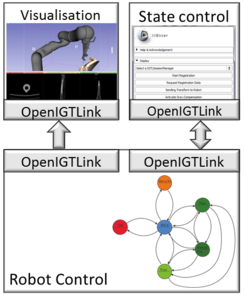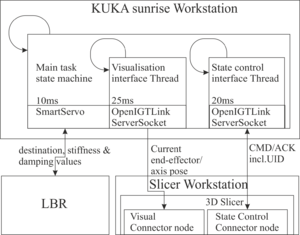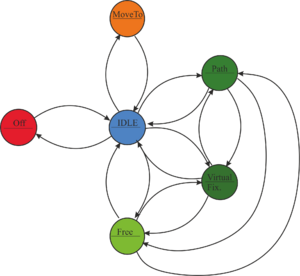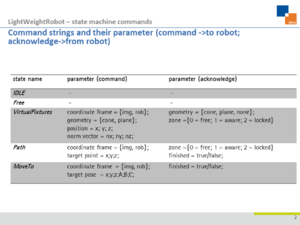Difference between revisions of "Documentation/Nightly/Extensions/LightWeightRobotIGT"
| Line 11: | Line 11: | ||
U54EB005 149) and is funded by KUKA Laboratories GmbH (Augsburg, Germany).<br> | U54EB005 149) and is funded by KUKA Laboratories GmbH (Augsburg, Germany).<br> | ||
Authors: Sebastian Tauscher, Junichi Tokuda<br> | Authors: Sebastian Tauscher, Junichi Tokuda<br> | ||
| − | Contact: Sebastian Tauscher, <email>sebastian.tauscher@imes.uni-hannover.de</email> [http://www.imes.uni-hannover.de Insitute of Mechatronics Systems], [http://www.uni-hannover.de Leibniz University Hannover]<br> | + | Contact: Sebastian Tauscher, <email>sebastian.tauscher@imes.uni-hannover.de</email>, [http://www.imes.uni-hannover.de Insitute of Mechatronics Systems], [http://www.uni-hannover.de Leibniz University Hannover]<br> |
<br> | <br> | ||
[[File:imesLogo.png|200px|center|thumb]] | [[File:imesLogo.png|200px|center|thumb]] | ||
| Line 18: | Line 18: | ||
<!-- ---------------------------- --> | <!-- ---------------------------- --> | ||
{{documentation/{{documentation/version}}/module-section|Module Description}} | {{documentation/{{documentation/version}}/module-section|Module Description}} | ||
| − | The LightWeightRobotIGT module | + | The LightWeightRobotIGT module allows to communicate with a light weight robot (LWR iiwa, KUKA Laboratories GmbH, Germany, Augsburg) using an open interface concept based on the [http://openigtlink.org/ OpenIGTLink protocol] (LWROpenIGTIF). Therefore, a state machine example is available at [http://www.example.com Git Hub] containing the necessary interface classes for the communication on the robot control. A tutorial on how to set up the robotic system for the use with this 3D Slicer module see [[Media:Tutorial_LightWeightRobotIGT_getting_started.pdf| LightWeightRobotIGT Getting Started]]. For an introduction of the interface concept see [[Media:Tutorial_LightWeightRobotIGT_Introduction.pdf| LightWeightRobotIGT Introduction]]. The module provides the following features: |
*Communication with the robot control | *Communication with the robot control | ||
| − | **Bidirectional cyclic communication with a state control running on the robot control | + | **Bidirectional cyclic communication via ethernet with a state control running on the robot control. Command strings of the type "CommandName;p1;...;pn;" with the parameters ''p1-pn'' needed to initialise the states are sent to the robot control and acknowledge strings are received (see table below for a list of all supported command and acknowledge strings and their parameters). |
| − | **Receiving the transformation matrix containing the pose of each robot joint in robot base coordinate frame and a matrix containing a similar transformation including information about the force direction, absolute value and application point. | + | **Receiving the transformation matrix containing the pose of each robot joint in robot base coordinate frame and a matrix containing a similar transformation including information about the force direction, absolute value, and application point. |
| − | ** | + | **Sending the transformation matrix describing the transformation from robot base coordinate frame to image space or to CT base coordinate frame |
*Visualisation | *Visualisation | ||
**A 3D model of the robot can be loaded and is automatically connected to the corresponding transformation matrices received from the robot control. | **A 3D model of the robot can be loaded and is automatically connected to the corresponding transformation matrices received from the robot control. | ||
| − | **The estimated force at the tool center point, e.g. the tool tip can be visualized by | + | **The estimated force at the tool center point, e.g. the tool tip, can be visualized by a scaled 3D arrow in the force direction. |
| − | **The color of the robot model changes | + | **The color of the robot model changes due to the current robot state received in the acknowledge string and, hence, gives a direct feedback to the user of the current robot state |
**Active virtual fixtures in relation to the robot and the target region changing their color to red when robot reach the fixtures | **Active virtual fixtures in relation to the robot and the target region changing their color to red when robot reach the fixtures | ||
{{Gallery | {{Gallery | ||
| Line 33: | Line 33: | ||
|lines=3 | |lines=3 | ||
|align=center | |align=center | ||
| − | | File:InterfaceConcept.png|Interface concept for the integration of | + | | File:InterfaceConcept.png|Interface concept for the integration of a robot into an image-guided therapy system consisting of a visualization and state control |
| File:TaskOverview.png|Overview of the communication structures and the threads on the robot control and the slicer workstation | | File:TaskOverview.png|Overview of the communication structures and the threads on the robot control and the slicer workstation | ||
| File:FiniteStateMachine_colored.png|Exemplary state machine for IGT | | File:FiniteStateMachine_colored.png|Exemplary state machine for IGT | ||
| − | | File:StateMachineCommands.png| | + | | File:StateMachineCommands.png|Command and acknowledge parameter set of the exemplary state machine |
}} | }} | ||
| Line 46: | Line 46: | ||
{{documentation/{{documentation/version}}/module-section|Tutorials}} | {{documentation/{{documentation/version}}/module-section|Tutorials}} | ||
*General interface concept and communication overview see [[Media:Tutorial_LightWeightRobotIGT_Introduction.pdf| LightWeightRobotIGT Introduction]] | *General interface concept and communication overview see [[Media:Tutorial_LightWeightRobotIGT_Introduction.pdf| LightWeightRobotIGT Introduction]] | ||
| − | * | + | *Tutorial on how to set up your system and start the example see [[Media:Tutorial_LightWeightRobotIGT_getting_started.pdf| LightWeightRobotIGT Getting Started]] |
| − | * | + | *How to add new states to the exemplary state machine see [[Media:Tutorial_LightWeightRobotIGT_add_module.pdf| LightWeightRobotIGT Add Module]] |
<!-- ---------------------------- --> | <!-- ---------------------------- --> | ||
{{documentation/{{documentation/version}}/module-section|Panels and their use}} | {{documentation/{{documentation/version}}/module-section|Panels and their use}} | ||
*''Start Communication'': Starts the cyclic communication with the state machine on the robot control | *''Start Communication'': Starts the cyclic communication with the state machine on the robot control | ||
| − | *''Start Visualisation'': | + | *''Start Visualisation'': Sends a command to the robot control to activate the visualisation |
| − | *''Stop Visualisation'': | + | *''Stop Visualisation'': Sends a command to the robot control to deactivate the visualisation |
| − | *''Load Robot'': | + | *''Load Robot'': Loads the stl-files of the robot and the tool from the path defined by "Path". |
*''Show TCP Force'': Visualizing the estimated force at the tool center point by a scaled 3D arrow pointing in force direction. | *''Show TCP Force'': Visualizing the estimated force at the tool center point by a scaled 3D arrow pointing in force direction. | ||
*Registration tab: | *Registration tab: | ||
| − | **''Free'': | + | **''Free'': Sends a transition request to the ''Free'' state to the robot control in which the robot can be moved freely and manually |
**''Get Fiducial'': Saves the current position in a fiducial list which can be used for a fiducial registration using modul XY | **''Get Fiducial'': Saves the current position in a fiducial list which can be used for a fiducial registration using modul XY | ||
*Prepositioning tab: | *Prepositioning tab: | ||
| − | **''Virtual Fixture'': | + | **''Virtual Fixture'': Sends a transition request to the ''VirtualFixtures'' state to the robot control in which the robot can be moved freely and manually in work space restricted by active constraints. The supported virtual fixtures geometries are ''plane'' and ''cone''. |
| − | **''PathImp'': | + | **''PathImp'': Sends a transition request to the ''Path'' state to the robot control in which the robot can be moved on a linear path from the current position towards a target position. |
*Targeting: | *Targeting: | ||
| − | **''Move To'': | + | **''Move To'': Sends a transition request to the ''MoveTo'' state to the robot control in which the robot moves position controlled towards a target position. |
| − | *''Reset Robot to Idle'': | + | *''Reset Robot to Idle'': Sends a transition request to the ''Idle'' state to the robot control |
*''Shut Down state machine'': Sends a command to shut down the state machine running on the robot control | *''Shut Down state machine'': Sends a command to shut down the state machine running on the robot control | ||
<!-- | <!-- | ||
Revision as of 15:09, 18 September 2014
Home < Documentation < Nightly < Extensions < LightWeightRobotIGT
|
For the latest Slicer documentation, visit the read-the-docs. |
Introduction and Acknowledgements
|
This work is supported in part by the National Institute of Health (R01CA111288, P01CA067165, P41RR019703,P41EB015898, R01CA124377, R01CA138586, R42CA137886, and
U54EB005 149) and is funded by KUKA Laboratories GmbH (Augsburg, Germany).
Module DescriptionThe LightWeightRobotIGT module allows to communicate with a light weight robot (LWR iiwa, KUKA Laboratories GmbH, Germany, Augsburg) using an open interface concept based on the OpenIGTLink protocol (LWROpenIGTIF). Therefore, a state machine example is available at Git Hub containing the necessary interface classes for the communication on the robot control. A tutorial on how to set up the robotic system for the use with this 3D Slicer module see LightWeightRobotIGT Getting Started. For an introduction of the interface concept see LightWeightRobotIGT Introduction. The module provides the following features:
Use CasesN/A Tutorials
Panels and their use
Similar ModulesN/A References
Information for Developers
|



